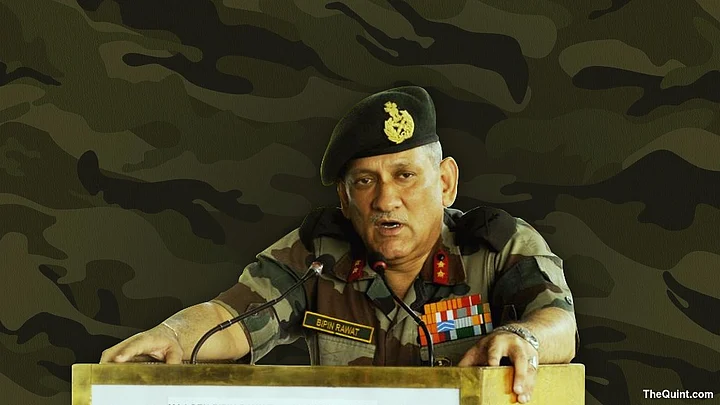Army Chief General Bipin Rawat’s views on whether or not to have women in frontline combat makes one thing clear; the Indian Army cannot have sexist men in combat roles. Especially when battle cry of the forces is about a woman, the Bharat Mata!
Now, those waiting for this kind of opportunity to redraw the line between the sexes might support General Rawat’s objections to women officers in combat roles. But those who stereotype women forget that they are also stereotyping men.
Behaviour of Jawans From Rural Areas
For instance, the General’s objection to women in combat roles seems to be based on the study of soldiers’ behaviour and, especially, men from rural areas.
The General fears that soldiers coming from rural background would find it difficult to accept the leadership of a woman. The General must come clean in public and reveal any surveys/data the Army might have on such conduct by soldiers hailing from rural India or if this is merely based on an unfair perception. Without such information, the General must refrain from painting ‘jawans from villages’ in such poor light.
To give just one example, according to 2018 report of Ministry of Statistics and Programme Implementation (MSPI), the women representatives in panchayats or elected village bodies is 46 percent in the country.
Rural men, obviously, do not have a problem voting and electing women panchayat members to represent their interests, and in following their leadership.
Women Officers Being Surrounded by a 100 Jawans
Further, he finds that a woman officer in combat operations would be surrounded by a 100 jawans. There should be no problem here either, considering that these are highly disciplined soldiers of the Indian Army.
But the General has his doubts. Just as he feels there might be complaints from the women officers that ‘somebody is peeping’ when they change clothes in the gym. The General seems especially worried that the present practice will have to be done away with of everyone changing in a common area.
These last bastions of the men like the gym changing room in the Army seem to be at risk from assertive women who represent India and defend what they stand for.
Appeal to the Conservative Mindset
Nothing, however, works better in such matters than to appeal to the conservative mindset, which supports women in the traditional roles of a mother, wife, widow, etc.
She should be the waiting wife, the patient mother and the grieving widow of the brave soldiers.
But when it comes to defending herself or her country, she must look to the man. Significantly, however, women already serve in uniform in India and it can be assumed that some of them are also mothers or will be in future.
Unfortunately, the General specifically targets the hapless rural male as someone who cannot bear to follow a woman or take orders from her. But, according to Census 2011, self-employed women in rural areas are at 59.3 percent compared to men at 54.5 percent.
That means, every second woman in rural areas is working and earning, while every second man is not. Men in rural parts of the country, as in urban India, are used to taking orders from their seniors in their jobs, irrespective of whether the colleague is a man or a woman. That’s called professionalism. Obviously, it is not men from rural India who do not have acceptance to women in equal roles, it is the General himself.
Finally, if rural India sustains today despite the intense agricultural distress being witnessed by the country, it is because there are women as farmers, entrepreneurs and as labour, standing by their households. The Census figures also show that 55.2 percent of agriculture labour is consisted of women, which is crucial for supporting rural households.
The General must realise that the soldiers he leads are not brought up by submissive women who would shiver at the sight of the enemy.
He should also refrain from questioning the patriotism of men by reducing them to stereotypical roles that would ridicule a fellow-soldier, whether a man or a woman. That is the kind of Army Chief the Indian Army deserves.
(Kota Neelima is an author and researcher. Her latest book is ‘Widows of Vidarbha: Making of Shadows’ by Oxford University Press, 2018. She tweets at @KotaNeelima. This is an opinion piece and the views expressed above are the author’s own. The Quint neither endorses nor is responsible for the same.)
